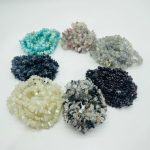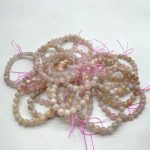Madagascar agate, renowned for its captivating patterns and vibrant hues, has captivated gemstone enthusiasts and artisans for centuries. Hailing from the vibrant island nation of Madagascar, this extraordinary stone has gained immense popularity due to its mesmerizing swirls, intricate banding, and exceptional durability. Join us on a journey to explore the fascinating world of Madagascar agate, uncovering its unique characteristics, diverse applications, and profound impact on art, jewelry, and healing practices.

Geological Origins: A Testament to Nature’s Artistic Mastery
Madagascar agate is a form of banded chalcedony, a mineral belonging to the quartz family. It derives its vibrant colors and patterns from trace elements present during its formation millions of years ago. As silica-rich groundwater seeps into cavities in volcanic rocks, it slowly crystallizes, forming agate’s iconic layers. The presence of elements such as iron, manganese, and copper infuses agate with its characteristic red, yellow, orange, and blue hues.
Physical Properties: A Stone of Strength and Resilience
Madagascar agate stands out for its exceptional hardness, reaching 6.5 to 7 on the Mohs scale. This durability makes it resistant to scratches and wear, ensuring its longevity in various applications. Notably, Madagascar agate boasts a low porosity, making it less susceptible to moisture absorption and staining. This characteristic enhances its resistance to external factors, preserving its beauty for years to come.
Color and Patterns: A Kaleidoscope of Hues and Designs
The most captivating feature of Madagascar agate lies in its mesmerizing color and pattern variations. Each stone is a unique masterpiece, showcasing a harmonious blend of hues ranging from soft pastels to vibrant primaries. From delicate lace agate with its intricate web-like patterns to bold fortification agate with its fortress-like formations, Madagascar agate offers a seemingly endless array of designs. No two stones are exactly alike, making each piece a true collector’s item.
Metaphysical Properties: A Stone of Balance and Harmony
Madagascar agate is highly valued in spiritual practices, believed to possess powerful healing and grounding energies. It is often associated with the root chakra, known to promote stability, security, and a deep connection to the earth. Many believe that Madagascar agate enhances emotional balance, reduces stress, and fosters a sense of inner peace and tranquility.
Applications in Jewelry: A Work of Art on Your Skin
Madagascar agate’s exquisite beauty has made it a favorite among jewelry designers and gemstone enthusiasts. Its durability allows for intricate carving and shaping, creating captivating pendants, earrings, bracelets, and rings. The stone’s versatility complements various metal settings, from delicate silver to bold gold, making it a versatile choice for any style or occasion.
Artistic Inspiration: A Muse for Masterpieces
Throughout history, Madagascar agate has inspired renowned artists and artisans. Its captivating patterns and colors have found expression in mosaics, sculptures, and decorative objects. From the intricate inlay work of ancient Egypt to contemporary abstract paintings, Madagascar agate continues to captivate the imaginations of creatives worldwide.
Table 1: Historical Significance of Madagascar Agate
| Era | Usage |
|---|---|
| Ancient Egypt | Inlay work in jewelry and artifacts |
| Roman Empire | Carvings and decorative objects |
| Renaissance Period | Intricate mosaics and cameos |
| 19th Century | Victorian mourning jewelry |
| 21st Century | Contemporary art and jewelry designs |
Table 2: Physical and Metaphysical Properties of Madagascar Agate
| Property | Value |
|---|---|
| Hardness | 6.5 – 7 Mohs |
| Porosity | Low |
| Color | Wide range of hues, including red, yellow, orange, blue, and white |
| Patterns | Lace agate, fortification agate, and various other designs |
| Metaphysical Properties | Grounding, emotional balance, stress reduction |
Table 3: Applications of Madagascar Agate
| Industry | Usage |
|---|---|
| Jewelry | Pendants, earrings, bracelets, rings |
| Art | Sculptures, mosaics, decorative objects |
| Home Decor | Countertops, backsplashes, decorative accents |
| Healing | Energy work, meditation, chakra balancing |
Table 4: Tips and Tricks for Caring for Madagascar Agate
| Tip | Description |
|---|---|
| Cleaning | Use a mild soap solution and a soft cloth to gently clean your Madagascar agate. Avoid harsh chemicals or abrasive cleaners. |
| Polishing | To restore Madagascar agate’s shine, use a polishing cloth or a non-abrasive polish. |
| Storage | Store Madagascar agate in a cool, dry place away from direct sunlight. |
| Handling | Handle Madagascar agate with care to avoid scratches or damage. |
FAQs: Unlocking the Mysteries of Madagascar Agate
Q: What makes Madagascar agate so unique?
A: Madagascar agate is distinguished by its captivating patterns and vibrant hues, resulting from trace elements present during its formation.
Q: Is Madagascar agate durable enough for everyday wear?
A: Yes, Madagascar agate is highly durable with a hardness of 6.5 to 7 on the Mohs scale, making it suitable for jewelry and various other applications.
Q: What are the potential healing benefits of Madagascar agate?
A: Madagascar agate is believed to promote emotional balance, reduce stress, and foster a sense of inner peace and tranquility.
Q: How can I care for my Madagascar agate jewelry?
A: Clean your Madagascar agate jewelry with a mild soap solution and a soft cloth. Avoid harsh chemicals or abrasive cleaners, and store it in a cool, dry place away from direct sunlight.
Q: Is Madagascar agate a good investment?
A: Madagascar agate is not typically considered an investment-grade gemstone. However, due to its increasing popularity, high-quality pieces can




























